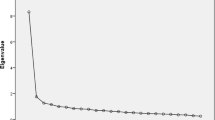Abstract
The Social Phobia and Anxiety Inventory (SPAI) has been developed to assess specific symptoms of social phobia and agoraphobia. Although the SPAI was developed with both clinical and nonclinical populations, research with this measure is currently focused primarily on clinical samples. We examined the factor structure and psychometric properties of the SPAI in adult community and college undergraduate samples. We found that single-sample and multisample confirmatory factor analyses provided support for extending use of the correlated two-factor SPAI subscales to our nonclinical samples. In addition, we found evidence for the internal consistency reliability of the SPAI subscales in both samples. Limitations and suggestions for future research are discussed.
Similar content being viewed by others
References
American Psychiatric Association (1994).Diagnostic and statistical manual of mental disorders (4th ed.). Washington, DC: APA.
Beidel, D. C., Borden, J. W., Turner, S. M., & Jacob, R. G. (1989). The Social Phobia and Anxiety Inventory: Concurrent validity with a clinical sample.Behaviour Research and Therapy, 27, 573–576.
Beidel, D. C., Turner, S. M., Stanley, M. A., & Dancu, C. V. (1989). The Social Phobia and Anxiety Inventory: Concurrent and external validity.Behavior Therapy, 20, 417–427.
Bentler, P. M. (1993).EQS structural equations program. Los Angeles: BMDP Statistical Software.
Bentler, P. M. (1993b).EQS structural equations program manual. Los Angeles: BMDP Statistical Software.
Bentler, P. M., & Bonnett, D. G. (1980). Significance tests and goodness-of-fit in the analysis of covariance structures.Psychological Bulletin, 88, 588–606.
Bentler, P. M., & Chou, C.-P. (1987). Practical issues in structural modeling.Sociological Methods and Research, 16, 78–117.
Bollen, K. A. (1989).Structural equations with latent variables. New York: Wiley.
Bollen, K. A., & Long, J. S. (Eds.) (1993).Testing structural equation models. Newbury Park, CA: Sage.
Bulik, C. M., Beidel, D. C., Duchmann, E., Weltzin, T. E., & Kaye, W. H. (1991). An analysis of social anxiety in anorexic, bulimic, social phobic, and control women.Journal of Psychopathology and Behavioral Assessment, 13, 199–211.
Clark, D. B., Turner, S. M., Beidel, D. C., Donovan, J. E., Kirisci, L., & Jacob, R. G. (1994). Reliability and validity of the Social Phobia and Anxiety Inventory for adolescents.Psychological Assessment, 6, 135–140.
Derogatis, L. R. (1992).The Brief Symptom Inventory (BSI): Administration, scoring and procedures manual II. Towson, MD: Clinical Psychometric Research.
Herbert, J. D., Bellack, A. S., & Hope, D. A. (1991). Concurrent validity of Social Phobia and Anxiety Inventory.Journal of Psychopathology and Behavioral Assessment, 13, 357–368.
Herbert, J. D., Hope, D. A., & Bellack, A. S. (1992). Validity of the distinction between generalized social phobia and avoidant personality disorder.Journal of Abnormal Psychology, 101, 332–339.
Hope, D. A., & Heimberg, R. G. (1993). Social phobia and social anxiety. In D. H. Barlow (Ed.),Clinical handbook of psychological disorders (pp. 99–136). New York: Guilford.
Hoyle, R. H., & Smith, G. T. (1994). Formulating clinical research hypotheses as structural equation models: A conceptual overview.Journal of Consulting and Clinical Psychology, 62, 429–440.
Marks, I. M., & Mathews, A. M. (1979). Brief self-rating for phobic patients.Behaviour Research and Therapy, 17, 263–267.
Osman, A., Barrios, F. X., Aukes, D., & Osman, J. R. (1995). Psychometric evaluation of the Social Phobia and Anxiety Inventory in college students.Journal of Clinical Psychology, 51, 235–243.
Turner, S. M., Beidel, D. C., Dancu, C. V., & Stanley, M. A. (1989). An empirically derived inventory to measure social fears and anxiety: The Social Phobia and Anxiety Inventory.Psychological Assessment: A Journal of Consulting and Clinical Psychology, 1, 35–40.
Turner, S. M., Stanley, M. A., Beidel, D. C., & Bond, L. (1989). The Social Phobia and Anxiety Inventory: Construct validity.Journal of Psychopathology and Behavioral Assessment, 11, 221–234.
Turner, S. M., Beidel, D. C., Borden, J. W., Stanley, M. A., & Jacob, R. G. (1991). Social phobia: Axis I and II correlates.Journal of Abnormal Psychology, 100, 102–106.
Turner, S. M., Beidel, D. C., & Townsley, R. M. (1992). Social phobia: A comparison of specific and generalized subtypes and avoidant personality disorder.Journal of Abnormal Psychology, 101, 326–331.
Watson, D., & Friend, R. (1969). Measurement of social-evaluative anxiety.Journal of Consulting and Clinical Psychology, 33, 448–457.
Author information
Authors and Affiliations
Rights and permissions
About this article
Cite this article
Osman, A., Barrios, F.X., Haupt, D. et al. The social phobia and anxiety inventory: Further validation in two nonclinical samples. J Psychopathol Behav Assess 18, 35–47 (1996). https://doi.org/10.1007/BF02229101
Accepted:
Issue Date:
DOI: https://doi.org/10.1007/BF02229101



